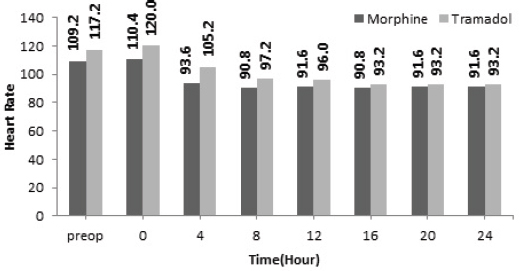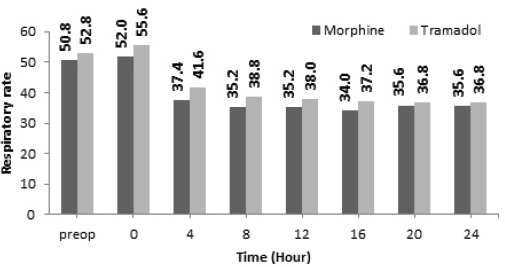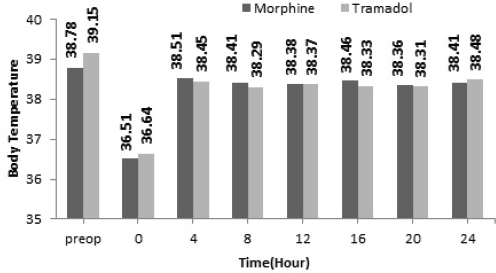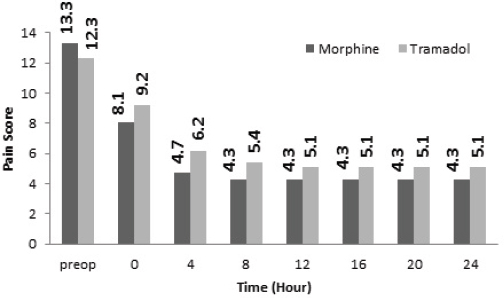
| Original Article | ||
Open Vet J. 2021; 11(4): 613-618 Open Veterinary Journal, (2021), Vol. 11(4): 613–618 Original Research Comparison of the analgesic effects of morphine and tramadol after tumor surgery in dogsÇağrı Gültekin*Department of Surgery, Faculty of Veterinary Medicine, Near East University, Nicosia, Cyprus *Corresponding Author: Çağrı Gültekin. Department of Surgery, Faculty of Veterinary Medicine, Near East University, Nicosia, Cyprus. Email: cagri.gultekin [at] neu.edu.tr Submitted: 05/07/2021 Accepted: 18/10/2021 Published: 09/11/2021 © 2021 Open Veterinary Journal
AbstractBackground: Pain thresholds may differ between animal species. It may even vary among individuals of the same species. Therefore, assessing pain in animals is challenging. Aims: The objective of the present study was to compare the analgesic effects of tramadol with morphine. Methods: The study was carried out on randomly selected 20 dogs with tumors in different breeds and gender. After induction of anesthesia with propofol, dogs were intubated, and anesthesia was maintained with sevoflurane. Intravenous fentanyl citrate was used for intraoperative analgesia after stabilization of the anesthesia. When the tumors were surgically removed and the operation was completed, dogs were divided into two groups to give the postoperative analgesic agent. The first 10 dogs to be investigated were identified as the morphine group and the second 10 dogs as the tramadol group. Postoperative pain scores, heart rates, respiratory rates, and body temperatures were recorded at 0, 4, 8, 12, 16, 20, and 24 hours after the operation. Results: Pain scores were lower in the morphine group than in the tramadol group during all postoperative processes. Conclusion: As a result, it was determined that tramadol has immediate analgesic effects than morphine; however, morphine provides better analgesia than tramadol. Keywords: Dog, Morphine, Pain management, Tramadol, Tumor. IntroductionIn cats and dogs, pain is often associated with tumors, surgery, chemotherapy, radiotherapy, or chronic diseases such as osteoarthritis (Duncan and Lascelles, 2007). Pain thresholds may differ between animal species. It may even vary among individuals of the same species. Therefore, assessing pain in animals is challenging (Mich and Hellyer, 2009). The general approach for drug use in pain management is listed in the following order: non-opioid drugs, weak opioid drugs, and potent opioid drugs (Hellyer et al., 2007). All opioids used clinically for this purpose show their analgesic effects as μ-receptor agonists (Lamont and Mathews, 2007). Opioid analgesics can be used as an intravenous bolus to achieve rapid analgesia during the postoperative period. Thus, the duration of absorption is reduced and rapid analgesia is achieved (Muir III, 2009). Tramadol is a synthetic derivative of codeine and is classified as an opioidergic/monoaminergic drug with weak μ-receptor agonist effects (Lamont and Mathews, 2007). Tramadol can be used to treat moderate to severe pain, such as osteoarthritis, fibromyalgia, diabetic neuropathy, neuropathic pain, and perioperative pain (Lacelles and Gaynor, 2007). This study aimed to examine the effects of tramadol on tumor-related pains and to compare its analgesic effects with morphine. Material and MethodsAnimalsThe research material consisted of 20 dogs with tumors, which included different breeds and both genders, brought to the Clinic of Surgery Department, Veterinary Faculty, Ankara University. The dogs were not provided any food for 12 hours preoperation. However, they were allowed to drink water. Anesthesia protocolSerum biochemical analysis (blood urea nitrogen, creatinine, alkaline phosphatase, alanine transaminase, aspartate transaminase, bilirubin, albumin, total protein, and gamma-glutamyl transferase) and complete blood count were carried out for preoperative diagnostic evaluation of the dogs. Chest radiographs were taken to exclude metastatic diseases. The age, body weights, heart rates, respiratory rates, body temperatures, and pain symptoms of the dogs were determined and recorded before the operation. Anesthesia induction was provided with propofol (4–6 mg/kg, propofol fresenius 1%; Istanbul, Turkey) by catheter (20 and 22 gauge; Bıçakcılar, Istanbul, Turkey) placed in V. cephalica antebrachial dorsalis. After tracheal intubation, anesthesia was continued with sevoflurane (Sevorane likid, AbbVie; Istanbul, Turkey). Electrocardiography electrodes were placed in the extremities, and heartbeats were monitored with the multichannel monitor (PETAS, KMA 460 R, Ankara, Turkey) during anesthesia. After stabilization of the anesthesia, fentanyl citrate (0.002–0.007 mg/kg, Fentanyl, Johnson and Johnson, Istanbul, Turkey) was applied as an intravenous bolus for the purpose of intraoperative analgesia. Once all surgical procedures were completed, the sevoflurane administration was discontinued, and oxygen was given to dogs to aid resuscitation. Analgesia protocolAfter the dogs’ swallowing reflexes had returned and extubated, we accepted this hour as 0th hour, and analgesics were applied. Ten dogs were placed in the morphine group and the other 10 dogs were placed in the tramadol group. At 4-hour intervals, 0.3 mg/kg IV morphine (Morphine HCl, Galen, İstanbul, Turkey) was administered to the morphine group, and 3 mg/kg IV tramadol (Contramal, Abdi İbrahim, İstanbul, Turkey) was administered to the tramadol group. Heart rates, respiratory rates, and body temperatures were measured at 0, 4, 8, 12, 16, 20, and 24 hours. Rectal temperature measurements were made using a digital thermometer (accuracy 0.1°C). Pain scores were evaluated and recorded using the University of Melbourne Pain Scale. Signs of behaviors such as body posture positions, vocalizations, attention to the environment and the caregiver, and appetite were also recorded. The pain score was accepted as normal for 0–9, and higher scores than 9 were accepted as an indicator of pain. In insufficient analgesia cases, 0.2 mg/kg IV morphine was administered to the morphine group, and 2 mg/kg IV tramadol was administered to the tramadol group as additional doses of analgesics. All dogs were evaluated by the same anesthetist. Statistical analysisData normality and homogeneity of variances were evaluated using the Shapiro–Wilk test and Levene’s test, respectively. According to the results obtained, the Student’s t-test was used to assess the statistical significance of the difference between drug groups in terms of related variables at each time period. Significance tests were carried out in assessing the heart rates, respiratory rates, body temperatures, and pain scores of the groups. The variation of variables related to each drug group over time was assessed by analysis of variance in repeated measures. p < 0.05 was accepted as statistically significant. Ethical approvalThe research was conducted with the approval of the Ethics Committee of the University of Ankara (2009-45 211). Consent for the inclusion of the patients in the study was obtained from the dog owners. ResultsHeart ratesIn both groups, heart rates at 0th hour were found higher than the preoperative values. The changes in heart rates between the preoperative and 0th hour were statistically significant (p < 0.05). The heart rates were observed as decreasing from the 4th hour in relation to the 0th hour (Fig. 1). Respiratory ratesThere were no significant differences between the groups in respiratory rates (p > 0.05) at all time periods (Fig. 2). Body temperaturesBody temperatures were significantly decreased in both groups at 0th hour. At the 4th hour, temperatures were closer to the preoperative values at all time periods. The difference between the groups at the 0th hour was statistically significant (p < 0.05) (Fig. 3). Pain scoresThe pain scores of the morphine group are lower than the tramadol group. The mean pain scores of both groups decreased over time (p < 0.001). This decrease in pain scores stopped and stabilized from the 8th hour. There were no significant differences between the groups in time-based comparisons. In other words, there were no significant differences between the mean pain severity of dogs using morphine or tramadol at any time (p > 0.05) (Fig. 4).
Fig 1. The heart rates of dogs’ preoperative and during a 24-hour period. The change in heart rates in both groups preoperative and 0 hour was found to be significant (p < 0.05).
Fig 2. Respiratory rates of dogs that were monitored for 24 hours according to the time given. No statistical difference was found in the respiratory rates between the dogs (p < 0.05). Signs of behaviorsIt was observed that the dogs in both groups were comfortable recovering from anesthesia, and there was no moaning, crying, or twitching. In general, mild inappetence was observed in both groups. The dogs in the morphine group ate from the 4th hour and the dogs in the tramadol group ate from the 8th hour. Any restlessness and dysphoria were not noted in the morphine group. Restlessness was detected in five dogs in the tramadol group. Postoperative turmoil continued in the 8th hour for one dog and for another up to 12 hours. Hunchback posture and shivering and shaking motion for 24 hours were noticed in two dogs from the tramadol group. Reluctant behaviors were observed in the same dogs for 8 hours. It was observed that postoperative restlessness ended in the 4th hour in another three of five dogs. DiscussionSome studies show that during the recovery from anesthesia, heart rates in the postoperative period were higher than the preoperative period. Heart rates decreased during the advancing postoperative hours and closed to the preoperative values. It was reported that these changes can result from increased locomotor activity during anesthesia awakening and from sympathetic stimulation during extubation (Lucas et al., 2001; Pekcan and Koç, 2010; Cagnardi et al., 2011). In this study, postoperative 0-hour heart rate measurements were higher than the preoperative period, while heart rate measurements in the morphine group were found to be closer to the preoperative period. However, postoperative 4th hour heart rate values were lower than the preoperative period (p < 0.05). It was thought that the increase in heart rate values at 0 hour in both groups may be due to increased locomotor activity during endotracheal extubation.
Fig 3. Body temperatures of dogs’ preoperative and during a 24-hour period following tumor excision. Zero hour and differences between groups were found to be statistically significant (p < 0.05).
Fig 4. Pain scores of dogs that are preoperative and within the first 24 hours as postoperation was given. Pain was scored using the University of Melbourne Pain Scale. Ten and above scores were indicative of greater pain on the scale. No significant difference was found in the comparison of both groups on time basis (p > 0.05). Opioids are known to cause hypothermia by affecting the hypothalamic thermoregulatory system, and this effect is primarily seen in dogs (Lamont and Mathews, 2007). It was observed that tramadol did not produce hypothermia in some studies (Monteiro et al., 2009; Malek et al., 2012; Cardoso et al., 2014). In this study, body temperatures were found lower in the postoperative 0th hour compared to the preoperative period. Decreasing body temperature at the 0th hour was observed to return to its standard value at the postoperative 4th hour. These changes at postoperative 0th hour maybe as a result of the opioid effect. It may be difficult to distinguish the difference between pain and dysphoria after trauma or surgery. Pain and dysphoria may occur simultaneously, but it is possible to distinguish the difference between pain and dysphoria with a few symptoms. The supply of pain can be determined by administering an additional or increased analgesic dose (Hellyer, 2007). Some studies revealed that the tramadol effect was shown after 3–4 hours due to the operation area and that additional doses of analgesics can be used (Martins et al., 2010; Buhari et al., 2013). It was observed that restlessness disappeared without additional dosage depending on the effectiveness of the analgesic agent in the 4th hour in three of the five restless dogs in the tramadol group. After an additional dose of tramadol was applied to two dogs whose restlessness took longer to subside, the observed perturbation ended. The calming of dogs with additional doses showed that the cause of the restlessness was pain-induced. Tramadol studies on cats and dogs demonstrated that, despite additional analgesic dose administration, the analgesic effect of tramadol is the same or sufficient as opioids and is a suitable alternative to the other analgesics (Mastrocinque and Fantoni, 2003; Martins et al., 2010; Cagnardi et al., 2011; Kongara et al., 2012, 2013; Teixeira et al., 2013). However, in studies on the effects of oral tramadol on orthopedic pain, it has been stated that the effect of tramadol is insufficient (Davila et al., 2013; Budsberg et al., 2018; Giudice et al., 2019). In addition, acute antinociceptive studies have reported that the effect of tramadol is inadequate, and its use in pain management is controversial (Kögel et al., 2014). Nevertheless, in studies on soft tissue surgery such as thoracotomy, mastectomy, ovariohysterectomy, and tumor surgery, it is stated that tramadol has a sufficient analgesic effect (Martins et al., 2010; Teixeira et al., 2013; Karrasch et al., 2015; Read et al., 2019). There was no statistically significant difference between morphine and tramadol in terms of pain scores in this study. The pain scores in both groups were close to each other and decreased from postoperative 8th hour. This condition changed at postoperative 4th hour. However, an additional dose of analgesic was given to five dogs in the tramadol group and a reduction in pain was observed. Besides, the hunchback posture and shaking movements that continued in two dogs, despite the generous additional dose of analgesic in the tramadol group, has indicated that the analgesic effect of tramadol was insufficient. As a result, it was observed that the dogs in the morphine group were more comfortable than the dogs in the tramadol group in terms of postoperative behavioral pain assessments. This study aimed, especially related to tumor surgery, to compare the efficacy of tramadol and morphine. When analgesic properties were evaluated, it was found that morphine was superior to tramadol, and dogs were more behaviorally comfortable in the postoperative period. In conclusion, the analgesic effectiveness of tramadol as a postoperative analgesic agent was found close to morphine but insufficient. AcknowledgmentsThe author would like to thank Assoc. Prof. Dr. Wayne Fuller for the English language proofreading and Prof. Dr. Bahattin Koç for his support. Conflict of interestThere is no financial or personal conflict of interest with other persons or organizations. ReferencesBudsberg, S.C., Torres, B.T., Kleine, S.A., Sandberg, G.S. and Berjeski, A.K. 2018. Lack of effectiveness of tramadol hydrochloride for the treatment of pain and joint dysfunction in dogs with chronic osteoarthritis. J. Am. Vet. Med. Assoc. 252, 427–432. Buhari, S., Kalthum, H., Goh, Y.M. and Gan, S.H. 2013. Influence of surgery on the pharmacokinetics of tramadol following intravenous administration in dogs. Asian J. Anim. Vet. Adv. 8, 483–492. Cagnardi, P., Villa, R., Zonca, A., Gallo, M., Beccaglia, M., Luvoni, G.C., Vettorato, E., Carli, S., Fonda, D. and Ravasio, G. 2011. Pharmacokinetics, intraoperative effect and postoperative analgesia of tramadol in cats. Res. Vet. Sci. 90, 503–509. Cardoso, C.G., Marques, D.R.C., Da Silva, T.H.M. and De Mattos-Junior, E. 2014. Cardiorespiratory, sedative and antinociceptive effects of dexmedetomidine alone or in combination with methadone, morphine or tramadol in dogs. Vet. Anaesth. Analg. 41, 636–643. Davila, D., Keeshen, T.P., Evans, R.B. and Conzemius, M.G. 2013. Comparison of the analgesic efficacy of perioperative firocoxib and tramadol administration in dogs undergoing tibial plateau leveling osteotomy. J. Am. Vet. Med. Assoc. 243, 225–231. Duncan, B. and Lascelles, X. 2007. Supportive care for cancer patient. In Withrow and Maceven’s small animal clinical oncology. Eds., Withrow, S.J. and Vail, D.M. St Louis, MO: Saunders, pp: 291–307. Giudice, E., Crinò, C., Barillaro, G., Crupi, R., Macrì, F., Viganò, F. and Di Pietro, S. 2019. Clinical findings in degenerative lumbosacral stenosis in ten dogs—a pilot study on the analgesic activity of tramadol and gabapentin. J. Vet. Behav. 33, 7–15. Hellyer, P.W. 2007. Pain management guidelines for dogs and cats. J. Am. Vet. Med. Assoc. 43, 235–248. Hellyer, P.W., Robertson, S.A. and Fails, A.D. 2007. Pain and its management. In Lumb and Jones’ veterinary anesthesia and analgesia. Eds., Thurmon, J.C., Tranquilli, W.J. and Grimm, K.A. Hoboken, NJ: Blackwell, pp: 31–57. Karrasch, N.M., Lerche, P., Aarnes, T.K., Gardner, H.L. and London, C.A. 2015. The effects of preoperative oral administration of carprofen or tramadol on postoperative analgesia in dogs undergoing cutaneous tumor removal. Can. Vet. J. 56, 817. Kögel, B., Terlinden, R. and Schneider, J. 2014. Characterisation of tramadol, morphine and tapentadol in an acute pain model in Beagle dogs. Vet. Anaesth. Analg. 41, 297–304. Kongara, K., Chambers, J.P. and Johnson, C.B. 2012. Effects of tramadol, morphine or their combination in dogs undergoing ovariohysterectomy on peri-operative electroencephalographic responses and post-operative pain. N. Z. Vet. J. 60, 129–135. Kongara, K., Chambers, J.P., Johnson, C.B. and Dukkipati, V.S. 2013. Effects of tramadol or morphine in dogs undergoing castration on intra-operative electroencephalogram responses and post-operative pain. N. Z. Vet. J. 61, 349–353. Lacelles, D.X. and Gaynor, J.S. 2007. Cancer patients. In Handbook of veterinary pain management. Eds., Gaynor, J.S. and Muir III, W.W. Maryland Heights, MO: Mosby, pp: 997–1008. Lamont, L.A. and Mathews, K.A. 2007. Opioids, nonsteroidal anti-inflammatories and analgesic adjuvants. In: Lumb and Jones’ beterinary anesthesia and analgesia. Eds., Thurmon, J.C., Tranquilli, W.J. and Grimm, K.A. Hoboken, NJ: Blackwell, pp: 241–270. Lucas, A.N., Firth, A.M., Anderson, G.A., Vine, J.H. and Edwards, G.A. 2001. Comparison of the effects of morphine administered by constant-rate intravenous infusion or intermitent intramuscular injection in dogs. J. Am. Vet. Med. Assoc. 218, 884–891. Malek, S., Sample, S.J., Schwartz, Z., Nemke, B., Jacobson, P.B.M., Cozzi, E.M., Schaefer, S.L., Bleedorn, J.A., Holzman, G. and Muir, P. 2012. Effect of analgesic therapy on clinical outcome measures in a randomized controlled trial using client-owned dogs with hip osteoarthritis. BMC Vet. Res. 8, 185–202. Martins, T.L., Kahvegian, M.A.P., Noel-Morgan, J., Leon-Román, M.A., Otsuki, D.A. and Fantoni, D.T. 2010. Comparison of the effects of tramadol, codeine, and ketoprofen alone or in combination on postoperative pain and on concentrations of blood glucose, serum cortisol, and serum interleukin- 6 in dogs undergoing maxillectomy or mandibulectomy. Am. J. Vet. Res. 71, 1019–1026. Mastrocinque, S. and Fantoni, D.T. 2003. A comparison of preoperative tramadol and morphine for the control of early postoperative pain in canine ovariohysterectomy. Vet. Anaesth. Analg. 30, 220–228. Mich, P.M. and Hellyer, P.W. 2009. Objective, catagoric methods for assessing pain and analgesia. In: Handbook of veterinary pain management. Eds., Gaynor, J.S. and Muir III, W.W. Maryland Heights, MO: Mosby, pp: 78–112. Monteiro, E.P., Junior, A.R., Assis, H.M.Q., Campagnol, D. and Quitzan, J.G. 2009. Comparative study on the sedative effects of morphine, methadone, butorphanol or tramadol in combination with acepromazine in dogs. Vet. Anaesth. Analg. 36, 25–33. Muir III, W.W. 2009. Selecting analgesic drugs and routes of drug administration. In: Handbook of veterinary pain management. Eds., Gaynor, J.S. and Muir III, W.W. Maryland Heights, MO: Mosby, pp: 337–352. Pekcan, Z. and Koç, B. 2010. The post-operative analgesic effects of epidurally administered morphine and transdermal fentanyl patch after ovariohysterectomy in dogs. Vet. Anaesth. Analg. 37, 557–565. Read, K., Khatun, M. and Murphy, H. 2019. Comparison of transdermal fentanyl and oral tramadol for lateral thoracotomy in dogs: cardiovascular and behavioural data. Vet. Anaesth. Analg. 46, 116–125. Teixeira, R.C., Monteiro, E.R., Campagnol, D., Coelho, K., Bressan, T.F. and Monteiro, B.S. 2013. Effects of tramadol alone, in combination with meloxicam or dipyrone, on postoperative pain and the analgesic requirement in dogs undergoing unilateral mastectomy with or without ovariohysterectomy. Vet. Anaesth. Analg. 40, 641–649. | ||
| How to Cite this Article |
| Pubmed Style Cağrı Gultekin. Comparison of the analgesic effects of morphine and tramadol after tumor surgery in dogs. Open Vet J. 2021; 11(4): 613-618. doi:10.5455/OVJ.2021.v11.i4.11 Web Style Cağrı Gultekin. Comparison of the analgesic effects of morphine and tramadol after tumor surgery in dogs. https://www.openveterinaryjournal.com/?mno=93680 [Access: September 01, 2024]. doi:10.5455/OVJ.2021.v11.i4.11 AMA (American Medical Association) Style Cağrı Gultekin. Comparison of the analgesic effects of morphine and tramadol after tumor surgery in dogs. Open Vet J. 2021; 11(4): 613-618. doi:10.5455/OVJ.2021.v11.i4.11 Vancouver/ICMJE Style Cağrı Gultekin. Comparison of the analgesic effects of morphine and tramadol after tumor surgery in dogs. Open Vet J. (2021), [cited September 01, 2024]; 11(4): 613-618. doi:10.5455/OVJ.2021.v11.i4.11 Harvard Style Cağrı Gultekin (2021) Comparison of the analgesic effects of morphine and tramadol after tumor surgery in dogs. Open Vet J, 11 (4), 613-618. doi:10.5455/OVJ.2021.v11.i4.11 Turabian Style Cağrı Gultekin. 2021. Comparison of the analgesic effects of morphine and tramadol after tumor surgery in dogs. Open Veterinary Journal, 11 (4), 613-618. doi:10.5455/OVJ.2021.v11.i4.11 Chicago Style Cağrı Gultekin. "Comparison of the analgesic effects of morphine and tramadol after tumor surgery in dogs." Open Veterinary Journal 11 (2021), 613-618. doi:10.5455/OVJ.2021.v11.i4.11 MLA (The Modern Language Association) Style Cağrı Gultekin. "Comparison of the analgesic effects of morphine and tramadol after tumor surgery in dogs." Open Veterinary Journal 11.4 (2021), 613-618. Print. doi:10.5455/OVJ.2021.v11.i4.11 APA (American Psychological Association) Style Cağrı Gultekin (2021) Comparison of the analgesic effects of morphine and tramadol after tumor surgery in dogs. Open Veterinary Journal, 11 (4), 613-618. doi:10.5455/OVJ.2021.v11.i4.11 |











